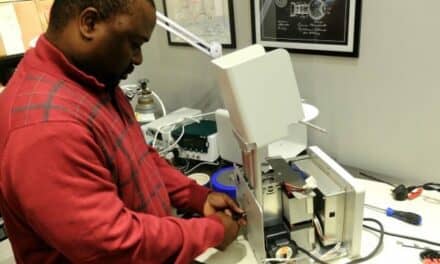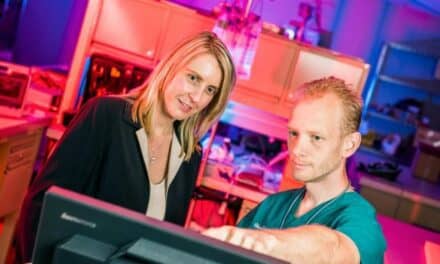China, Ethiopia, the Caribbean: this biomed has taken his skills around the world to help combat blindness.
 From the very beginning of my biomedical engineering career, I knew that I had to do something other than routine biomed jobs, but I did not know exactly what that could be. From the very beginning of my biomedical engineering career, I knew that I had to do something other than routine biomed jobs, but I did not know exactly what that could be. |
 Ismael Cordero with a welcoming committee in Taiyuan, China. Ismael Cordero with a welcoming committee in Taiyuan, China.
Fixing things in the basement of a large hospital was interesting and rewarding only to a certain extent, and most workdays seemed more or less the same. One day by accident I came across an advertisement for a biomed position with the nonprofit organization ORBIS International. What caught my attention was that the job was onboard an airplane. Not just any ordinary airplane—this was a DC-8 aircraft converted into a fully functional eye hospital that traveled the globe teaching eye-care professionals how to combat blindness in their countries. This was different, all right, and exactly the change I needed. |
 The ORBIS DC-10’s audiovisual studio. The ORBIS DC-10’s audiovisual studio.
The following week I was interviewing for the position, and a month after the interview, I had the job. Two months later, I was headed to Tunisia to join the ORBIS DC-8 and its crew. Since that day in 1994, I have traveled to more than 20 countries in Asia, Africa, Eastern Europe, South America, and the Caribbean. |
 The ORBIS DC-10 classroom can seat up to 50 participants. Larger groups can be accommodated in a peripheral classroom in the airport where the program is broadcast from the plane via an infrared transmitter. The ORBIS DC-10 classroom can seat up to 50 participants. Larger groups can be accommodated in a peripheral classroom in the airport where the program is broadcast from the plane via an infrared transmitter. |
 The ORBIS DC-10 recovery room has 3 gurney stations with patient monitors, suction, and oxygen. The ORBIS DC-10 recovery room has 3 gurney stations with patient monitors, suction, and oxygen. |
The Flying Hospital Gets a New Home
 ORBIS biomedical engineers (left to right) Xiaoming Cheng and Phil Abad along with flight mechanic James Salillas find some quiet time to send emails to friends back home. ORBIS biomedical engineers (left to right) Xiaoming Cheng and Phil Abad along with flight mechanic James Salillas find some quiet time to send emails to friends back home. |
 ORBIS biomedical engineer Sanjeev Hiremath (right) and Samson Terefe (left) working on a Zeiss microscope in Ethiopia. ORBIS biomedical engineer Sanjeev Hiremath (right) and Samson Terefe (left) working on a Zeiss microscope in Ethiopia. |
 Wang Ang Fen (left) tests a circuit board as part of his biomedical engineeringtraining. Wang Ang Fen (left) tests a circuit board as part of his biomedical engineeringtraining.
Soon after I joined ORBIS, the aging DC-8 was retired, and the flying eye hospital was transferred to a newly converted DC-10 aircraft. The DC-10 offered twice the floor space of the DC-8 and was fully equipped with state-of-the-art medical, communications, and audiovisual systems. The interior of the ORBIS DC-10 is so much like that of any hospital back home that on many occasions I would forget I was on an airplane. The plane’s biomed shop is even down in the basement of the plane—its belly—just as it is in a regular hospital. |

The plane has a 50-seat classroom, where people can observe live video broadcasts of the surgeries being performed in the operating room, and they can ask the surgeons questions. Lectures and demonstrations also take place in the classroom. The digital audiovisual studio is where all the surgeries, procedures, and demonstrations are broadcast and recorded so that edited training videos can be left behind in each country we visit. The plane has 17 built-in cameras and 54 monitors, a water purification system, compressed air, an oxygen concentrator, suction, a Windows NT computer network, a battery backup system for the operating room, and a phone system. The biomeds maintain all of these items as well as the diagnostic, surgical, anesthesia, laser, and patient monitoring equipment.
|
The ORBIS Vision |
 ORBIS International envisions a world in which avoidable blindness is eliminated, a world of high-quality eye-care treatment for every human being, especially the more than 180 million who are blind, severely visually impaired, or at risk of becoming blind. Right now, 80% of those who are blind do not need to be. Millions can be cured with techniques routinely practiced in many countries. A nonprofit, humanitarian organization, ORBIS works in developing countries to save sight through hands-on training, public-health education, and improved access to eye care. By training professionals who then can train their colleagues, ORBIS achieves the greatest possible impact on the quality of eye-care services. To date, nearly 500 training programs in 81 countries have enhanced the skills of more than 55,500 health care professionals. ORBIS International envisions a world in which avoidable blindness is eliminated, a world of high-quality eye-care treatment for every human being, especially the more than 180 million who are blind, severely visually impaired, or at risk of becoming blind. Right now, 80% of those who are blind do not need to be. Millions can be cured with techniques routinely practiced in many countries. A nonprofit, humanitarian organization, ORBIS works in developing countries to save sight through hands-on training, public-health education, and improved access to eye care. By training professionals who then can train their colleagues, ORBIS achieves the greatest possible impact on the quality of eye-care services. To date, nearly 500 training programs in 81 countries have enhanced the skills of more than 55,500 health care professionals.
ORBIS operates the world’s only flying eye hospital and has program offices in India, China, Bangladesh, Ethiopia, and Vietnam. For more information, please visit www.orbis.org. If you are interested in volunteering for ORBIS as a biomedical engineer or technician for 1 week of training, support, or assessment activities, please contact Ismael Cordero, health care technology specialist, by email at [email protected] or by phone at (646) 674-5511. ORBIS is also looking for hospital sites that would like to host international biomedical engineering interns. |
Flying Eye Hospital Presents Unique Challenges

Working on the ORBIS DC-10 presents many challenges. For one thing, the limited space on the plane does not permit stocking many spare parts. The plane is normally stocked about three times a year during crew breaks. Emergency repair parts are ordered through the New York office via email and hand-carried to the plane by volunteer faculty. Many times in desperation, the crew resorts to local markets where many makeshift parts can be found if you search long and hard enough. Getting technical support over the phone from a US manufacturer for troubleshooting is also difficult when one is 8,000 miles away with a 9-hour time-zone difference—not to mention costly since the toll-free phone numbers do not work from abroad. An additional challenge not encountered in traditional biomedical engineering departments is having to secure all medical and other equipment for flight. All instruments are either placed in a secure housing built into the plane or put in padded boxes and secured to the aircraft floor with specially designed nets and harnesses.

The DC-10 biomeds take turns going to the local hospitals to perform repairs and to train local engineers and technicians on the maintenance and management of medical equipment. Training is provided through lectures and hands-on workshops tailored to the needs of each location. In some developing countries, we find that many hospitals have no biomed support at all. In others, we may find that a centralized government medical-maintenance department in the capital takes care of all of the medical equipment for all of the hospitals in the country. In most cases, there are few resources and very limited access to spare parts, manuals, tools, and test equipment. Also, many inappropriate donations are made by foreign organizations that fail to take into account the level of sustainability of the technology in the recipient country. These issues, coupled with the low importance given to biomedical engineering professionals, hinder the ability of biomeds to do their job. Despite this, I have witnessed many instances of ingenuity and resourcefulness in keeping vital medical devices running.

Several examples stand out in my mind. One of them is in Khartoum, Sudan. The central biomed facility there makes their own rubber gaskets and O-rings out of used-car tires, since procurement from international markets can take months and sometimes years, and there is no budget for stocking these items. I was shown several of the “homemade” gaskets, and, honestly, I could not tell much difference from the real thing. In Yangon, Myanmar, I learned that the biomeds rewire electric motor coils when they break down. In Camaguey, Cuba, I saw biomeds draw electronic schematics for complex circuit boards from scratch by tracing all of the components and circuit paths on the board. They saved these drawings for future troubleshooting.

Mathew Du Vall (right) with counterparts in Damascus, Syria.
During my time on the plane, I have seen many impressive sites, such as the Great Wall of China and the Inca ruins of Machu Picchu in Peru. I have also met many public figures, including Mother Theresa, Princess Diana, and Fidel Castro, but the people who have made the most impact on my life are the plane’s international team—usually from about 12 countries—and our biomed counterparts in the countries that have hosted us.

Biomed group standing by a public awareness sign indicating that more than 50% of medical equipment in Ethiopia is in a state of disrepair.
Sadly, I no longer work on the ORBIS DC-10. I now work for ORBIS at its headquarters in New York City, where I am responsible for providing technical support to our eye-care programs to ensure that our local partners can sustain the technology needed to prevent and treat blindness. It is not as adventurous as flying around the world on the DC-10, but I know that my wife and my daughter both appreciate my being home more. I am grateful to ORBIS for giving me the opportunity to see so much of the world and to help such a noble cause. In the words of Boutros Boutros-Ghali, former secretary general to the United Nations, “ORBIS is an excellent example of what can be achieved by people cooperating to help their fellow human beings.”
Ismael Cordero is the health care technology specialist at ORBIS International in New York City. He has worked with ORBIS since 1994, and prior to that, he worked as a biomedical equipment technician for several hospitals in Philadelphia. He received his BS in biomedical engineering technology from Temple University in 1989.
| A Day in the Life We would like to hear about your day in the service industry: Tell us the problems you encounter, and share the solutions. Articles should be no more than 1,500 words in length and can be sent to 24×7 via mail to Editor, 24×7, 6701 Center Drive West, Suite 450, Los Angeles, CA 90045; or via email to [email protected]. |




